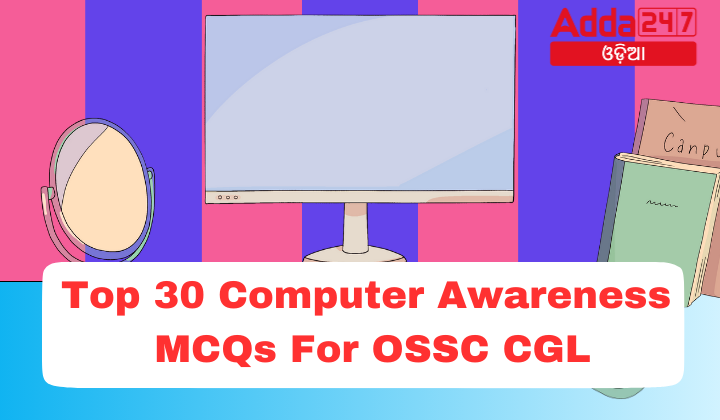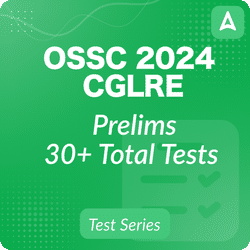Prepare for the OSSC CGL with these Top 30 Computer Awareness MCQs, designed to enhance your knowledge. Covering fundamental concepts in computing, from hardware to software and beyond, these questions aim to sharpen your understanding and boost your confidence. Whether you’re familiarizing yourself with basic terminology or delving into more advanced topics, this curated set ensures comprehensive preparation. Master concepts like operating systems, networking, and data structures, vital for success in the OSSC CGL examination. Elevate your computer awareness proficiency and ace the test with ease.
Top 30 Computer Awareness MCQs For OSSC CGL 2024
1. What defines a Bus Topology?
(a) Each node is connected to a central hub.
(b) All nodes are connected in a circular manner.
(c) Each node is connected to a single central cable.
(d) Each node is connected to every other node directly.
S1. Ans. (c) Each node is connected to a single central cable.
2. What is a key advantage of a Ring Topology?
(a) Easy installation and setup.
(b) High fault tolerance and easy troubleshooting.
(c) The addition of nodes does not affect network performance significantly.
(d) Cost-effective for large networks.
S2. Ans. (c) The addition of nodes does not affect network performance significantly.
3. In which topology does the central hub act as a repeater?
(a) Mesh Topology
(b) Star Topology
(c) Bus Topology
(d) Ring Topology
S3. Ans. (b) Star Topology
4. What is a disadvantage of the Mesh Topology?
(a) High cost of installation and maintenance.
(b) High fault tolerance.
(c) Low network traffic impact.
(d) Simple troubleshooting.
S4. Ans. (a) High cost of installation and maintenance.
5. Which topology is known for creating a physical ring structure where each node is connected to its two immediate neighbors?
(a) Star Topology
(b) Mesh Topology
(c) Ring Topology
(d) Bus Topology
S5. Ans. (c) Ring Topology
6. What is a characteristic of a Hybrid Topology?
(a) It combines two or more different types of topologies.
(b) It connects each device directly to every other device.
(c) It has a single central node to which all devices are connected.
(d) It is only used for very small networks.
S6. Ans. (a) It combines two or more different types of topologies.
7. Which topology requires the least amount of cabling and is best suited for small networks?
(a) Mesh Topology
(b) Bus Topology
(c) Star Topology
(d) Tree Topology
S7. Ans. (b) Bus Topology
8. In a Star Topology, what happens if the central hub fails?
(a) Only the directly connected nodes fail.
(b) The entire network remains operational.
(c) The whole network is halted.
(d) The nodes are able to reconfigure themselves to maintain connectivity.
S8. Ans. (c) The whole network is halted.
9. How does Mesh Topology handle data transmission?
(a) By sending data to all nodes and letting them find the destination.
(b) By using a central hub to route data.
(c) By sending data through a single cable.
(d) By sending data in a ring structure to all nodes.
S9. Ans. (a) By sending data to all nodes and letting them find the destination.
10. What is the main benefit of a Tree Topology?
(a) High fault tolerance due to its hierarchical structure.
(b) Low cabling cost.
(c) Simplicity in configuration.
(d) No need for additional hardware components.
S10. Ans. (a) High fault tolerance due to its hierarchical structure.
11. What is the primary function of a network hub?
(a) To route data to the destination device based on its MAC address
(b) To regenerate and strengthen data signals before transmission
(c) To connect networking nodes physically and broadcast data to all ports
(d) To convert data formats between different types of networks
S11. Ans. (c)
12. Which type of hub is responsible for regenerating and strengthening data signals?
(a) Passive Hub
(b) Transparent Hub
(c) Active Hub
(d) Ethernet Hub
S12. Ans. (c)
13. How does a switch differ from a hub in terms of data transmission?
(a) A switch sends data to all ports, while a hub sends data to the destination port only
(b) A switch transmits data to the destination port only, while a hub sends data to all ports
(c) A switch converts data formats, while a hub does not
(d) A switch and a hub perform the same function in data transmission
S13. Ans. (b)
14. In which mode do switches operate that allows nodes to send and receive data simultaneously?
(a) Half-duplex
(b) Full-duplex
(c) Simplex
(d) Multicast
S14. Ans. (b)
15. What is the main advantage of using switches over Ethernet hubs?
(a) Switches provide error checking, while hubs do not
(b) Switches work in full-duplex mode, while hubs work in half-duplex mode
(c) Switches are less expensive compared to hubs
(d) Switches can only connect Ethernet devices, while hubs can connect various types of devices
S15. Ans. (b)
16. What is a key characteristic of a transparent bridge?
(a) It converts data formats between different networks
(b) It allows devices to be aware of its existence
(c) It manages data flow based on MAC addresses without the devices being aware
(d) It determines the path of data packets within the network
S16. Ans. (c)
17. Which type of bridge is used to convert data formats between different network types?
(a) Transparent Bridge
(b) Source Route Bridge
(c) Translational Bridge
(d) Active Bridge
S17. Ans. (c)
18. How does cut-through transmission differ from store-and-forward transmission in switches?
(a) Cut-through transmission checks for errors before forwarding data, while store-and-forward does not
(b) Store-and-forward transmission sends packets as soon as they are received, while cut-through checks for errors
(c) Cut-through transmission checks for errors in the entire packet, while store-and-forward transmits packets immediately
(d) Store-and-forward transmission is faster compared to cut-through transmission
S18. Ans. (b)
19. What is the primary role of a network bridge?
(a) To connect different types of network cables
(b) To manage data flow between devices in the same network segment
(c) To link different networks using the same protocol and create larger logical networks
(d) To enhance the speed of data transfer in a network
S1.9 Ans. (c)
20. Why are Ethernet switches referred to as “multiport bridges”?
(a) Because they perform data format conversions between different networks
(b) Because they operate in a transparent manner like bridges
(c) Because they offer higher functionality and multiple ports compared to trade S20. Ans. (c)
21. When was Microsoft Outlook 97 released?
(a) January 16, 1997
(b) June 21, 1998
(c) June 27, 1999
(d) May 31, 2001
S21. Ans. (a) January 16, 1997
22. Which version of Microsoft Outlook was included in Office XP?
(a) Outlook 97
(b) Outlook 2000
(c) Outlook 2002
(d) Outlook 2003
S22. Ans. (c) Outlook 2002
23. What feature was introduced in Outlook 2003?
(a) Preview attachments
(b) Expandable distribution list
(c) People hub
(d) Cloud computing
S23. Ans. (b) Expandable distribution list
24. When was Microsoft Outlook 2010 released?
(a) January 27, 2007
(b) July 15, 2010
(c) January 29, 2013
(d) September 22, 2015
S23. Ans. (b) July 15, 2010
25. Which version of Outlook introduced the “People hub” feature?
(a) Outlook 2003
(b) Outlook 2007
(c) Outlook 2010
(d) Outlook 2013
S23. Ans. (d) Outlook 2013
26. What significant feature was added in Outlook 2016?
(a) Group redesign
(b) Social connector
(c) Attachment prompt
(d) Scheduling meetings
S26. Ans. (a) Group redesign
27. In which version did Microsoft Outlook support multiple time zones?
(a) Outlook 2000
(b) Outlook 2007
(c) Outlook 2013
(d) Outlook 2019
S27. Ans. (d) Outlook 2019
28. What is a notable feature of Outlook 2007?
(a) Unicode support
(b) PDF and XLS file export
(c) Integration with MSN Messenger
(d) Filtering of spam emails
S28. Ans. (b) PDF and XLS file export
29. When was Outlook 98 made available?
(a) June 21, 1998
(b) January 16, 1997
(c) September 24, 2018
(d) November 20, 2003
S29. Ans. (a) June 21, 1998
30. Which version of Outlook introduced support for cloud computing?
(a) Outlook 2010
(b) Outlook 2013
(c) Outlook 2016
(d) Outlook 2019
S30. Ans. (c) Outlook 2016





